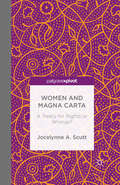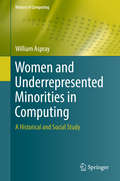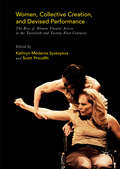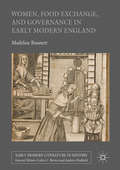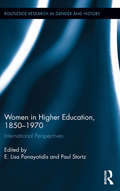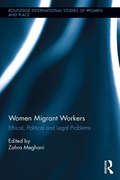- Table View
- List View
Women and Gift Exchange in Eighteenth-Century Fiction: Richardson, Burney, Austen (Routledge Studies in Eighteenth-Century Literature)
by Linda ZionkowskiThis book analyzes why the most influential novelists of the long eighteenth century centered their narratives on the theory and practice of gift exchange. Throughout this period, fundamental shifts in economic theories regarding the sources of individual and national wealth along with transformations in the practices of personal and institutional charity profoundly altered cultural understandings of the gift's rationale, purpose, and function. Drawing on materials such as sermons, conduct books, works of political philosophy, and tracts on social reform, Zionkowski challenges the idea that capitalist discourse was the dominant influence on the development of prose fiction. Instead, by shifting attention to the gift system as it was imagined and enacted in the formative years of the novel, the volume offers an innovative understanding of how the economy of obligation shaped writers' portrayals of class and gender identity, property, and community. Through theoretically-informed readings of Richardson's Clarissa and Sir Charles Grandison, Burney's Cecilia and The Wanderer, and Austen's Mansfield Park and Emma, the book foregrounds the issues of donation, reciprocity, indebtedness, and gratitude as it investigates the conflicts between the market and moral economies and analyzes women's position at the center of these conflicts. As this study reveals, the exchanges that eighteenth-century fiction prescribed for women confirm the continuing power and importance of gift transactions in the midst of an increasingly commercial culture. The volume will be essential reading for scholars of the eighteenth-century novel, economic literary criticism, women and gender studies, and book history.
Women and The Magna Carta: A Treaty for Control or Freedom?
by Jocelynne ScuttOn the eight-hundredth anniversary of the Magna Carta, Women and the Magna Carta investigates what the charter meant for women's rights and freedoms from an historical and legal perspective.
Women and Monastic Buddhism in Early South Asia: Rediscovering the invisible believers (Archaeology and Religion in South Asia)
by Garima KaushikThis book uses gender as a framework to offer unique insights into the socio-cultural foundations of Buddhism. Moving away from dominant discourses that discuss women as a single monolithic, homogenous category—thus rendering them invisible within the broader religious discourse—this monograph examines their sustained role in the larger context of South Asian Buddhism and reaffirms their agency. It highlights the multiple roles played by women as patrons, practitioners, lay and monastic members, etc. within Buddhism. The volume also investigates the individual experiences of the members, and their equations and relationships at different levels—with the Samgha at large, with their own respective Bhikşu or Bhikşunī Sangha, with the laity, and with members of the same gender (both lay and monastic). It rereads, reconfigures and reassesses historical data in order to arrive at a new understanding of Buddhism and the social matrix within which it developed and flourished. Bringing together archaeological, epigraphic, art historical, literary as well as ethnographic data, this volume will be of interest to researchers and scholars of Buddhism, gender studies, ancient Indian history, religion, and South Asian studies.
Women and Monastic Buddhism in Early South Asia: Rediscovering the invisible believers (Archaeology and Religion in South Asia)
by Garima KaushikThis book uses gender as a framework to offer unique insights into the socio-cultural foundations of Buddhism. Moving away from dominant discourses that discuss women as a single monolithic, homogenous category—thus rendering them invisible within the broader religious discourse—this monograph examines their sustained role in the larger context of South Asian Buddhism and reaffirms their agency. It highlights the multiple roles played by women as patrons, practitioners, lay and monastic members, etc. within Buddhism. The volume also investigates the individual experiences of the members, and their equations and relationships at different levels—with the Samgha at large, with their own respective Bhikşu or Bhikşunī Sangha, with the laity, and with members of the same gender (both lay and monastic). It rereads, reconfigures and reassesses historical data in order to arrive at a new understanding of Buddhism and the social matrix within which it developed and flourished. Bringing together archaeological, epigraphic, art historical, literary as well as ethnographic data, this volume will be of interest to researchers and scholars of Buddhism, gender studies, ancient Indian history, religion, and South Asian studies.
Women and the Orange Order: Female activism, diaspora and empire in the British world, 1850–1940 (PDF)
by D. A. MacphersonWomen and the Orange Order examines the growth and activism of Orange women in England, Scotland and Canada since the mid-nineteenth century and argues that they were central to the development of Orange associational culture up to the Second World War. This study also explores how women were key participants in the formation of diasporic connections throughout the British world, building on links created by migration and the Empire. It reveals that the ordinary - and largely working-class - women who joined the Orange Order eagerly engaged in the public lives of their communities, in conservative politics and in upholding the ideologies of the British Empire. In its examination of gender, ethnicity, class and imperialism, Women and the Orange Order will appeal to readers interested in the history of the Irish diaspora, women's public activism and the British Empire.
Women and the Orange Order: Female activism, diaspora and empire in the British world, 1850–1940
by D. A. MacphersonWomen and the Orange Order examines the growth and activism of Orange women in England, Scotland and Canada since the mid-nineteenth century and argues that they were central to the development of Orange associational culture up to the Second World War. This study also explores how women were key participants in the formation of diasporic connections throughout the British world, building on links created by migration and the Empire. It reveals that the ordinary - and largely working-class - women who joined the Orange Order eagerly engaged in the public lives of their communities, in conservative politics and in upholding the ideologies of the British Empire. In its examination of gender, ethnicity, class and imperialism, Women and the Orange Order will appeal to readers interested in the history of the Irish diaspora, women's public activism and the British Empire.
Women and Underrepresented Minorities in Computing: A Historical and Social Study (History of Computing #0)
by William AsprayThis text examines in detail the issue of the underrepresentation of women, African Americans, American Indians, and Hispanics in the computing disciplines in the U.S. The work reviews the underlying causes, as well as the efforts of various nonprofit organizations to correct the situation, in order to both improve social equity and address the shortage of skilled workers in this area. Topics and features: presents a digest and historical overview of the relevant literature from a range of disciplines, including leading historical and social science sources; discusses the social and political factors that have affected the demographics of the workforce from the end of WWII to the present day; provides historical case studies on organizations that have sought to broaden participation in computing and the STEM disciplines; reviews the different approaches that have been applied to address underrepresentation, at the individual, system-wide, and pathway-focused level; profiles the colleges and universities that have been successful in opening up computer science or engineering to female students; describes the impact of individual change-agents as well as whole organizations.
Women at the Beginning: Origin Myths from the Amazons to the Virgin Mary
by Patrick J. GearyIn these four artfully crafted essays, Patrick Geary explores the way ancient and medieval authors wrote about women. Geary describes the often marginal role women played in origin legends from antiquity until the twelfth century. Not confining himself to one religious tradition or region, he probes the tensions between women in biblical, classical, and medieval myths (such as Eve, Mary, Amazons, princesses, and countesses), and actual women in ancient and medieval societies. Using these legends as a lens through which to study patriarchal societies, Geary chooses moments and texts that illustrate how ancient authors (all of whom were male) confronted the place of women in their society. Unlike other books on the subject, Women at the Beginning attempts to understand not only the place of women in these legends, but also the ideologies of the men who wrote about them. The book concludes that the authors of these stories were themselves struggling with ambivalence about women in their own worlds and that this struggle manifested itself in their writings.
Women at the Beginning: Origin Myths from the Amazons to the Virgin Mary
by Patrick J. GearyIn these four artfully crafted essays, Patrick Geary explores the way ancient and medieval authors wrote about women. Geary describes the often marginal role women played in origin legends from antiquity until the twelfth century. Not confining himself to one religious tradition or region, he probes the tensions between women in biblical, classical, and medieval myths (such as Eve, Mary, Amazons, princesses, and countesses), and actual women in ancient and medieval societies. Using these legends as a lens through which to study patriarchal societies, Geary chooses moments and texts that illustrate how ancient authors (all of whom were male) confronted the place of women in their society. Unlike other books on the subject, Women at the Beginning attempts to understand not only the place of women in these legends, but also the ideologies of the men who wrote about them. The book concludes that the authors of these stories were themselves struggling with ambivalence about women in their own worlds and that this struggle manifested itself in their writings.
Women, Collective Creation, and Devised Performance: The Rise of Women Theatre Artists in the Twentieth and Twenty-First Centuries
by Kathryn Mederos Syssoyeva Scott ProudfitThis book explores the role and centrality of women in the development of collaborative theatre practice, alongside the significance of collective creation and devising in the development of the modern theatre. Tracing a web of women theatremakers in Europe and North America, this book explores the connections between early twentieth century collective theatre practices such as workers theatre and the dramatic play movement, and the subsequent spread of theatrical devising. Chapters investigate the work of the Settlement Houses, total theatre in 1920s’ France, the mid-century avant-garde and New Left collectives, the nomadic performances of Europe’s transnational theatre troupes, street-theatre protests, and contemporary devising. In so doing, the book further elucidates a history of modern theatre begun in A History of Collective Creation (2013) and Collective Creation in Contemporary Performance (2013), in which the seemingly marginal and disparate practices of collective creation and devising are revealed as central—and women theatremakers revealed as progenitors of these practices.
Women, credit, and debt in early modern Scotland (Gender in History)
by Cathryn SpenceThis text provides the first full-length consideration of women’s economic roles in early modern Scottish towns. Drawing on tens of thousands of cases entered into burgh court litigation between 1560 and 1640 in Edinburgh, Dundee, Haddington and Linlithgow, Women, credit and debt explores how Scottish women navigated their courts and their communities. The employments and by-employments that brought these women to court and the roles they had in the economy are also considered. In particular, this book explores the role of women as merchants, merchandisers, producers and sellers of ale, landladies, moneylenders and servants. Comparing the Scottish experience to that of England and Europe, Spence shows that over the course of the latter half of the sixteenth century and into the seventeenth century women were conspicuously active in burgh court litigation and, by extension, were engaged participants in the early modern Scottish economy.
Women, credit, and debt in early modern Scotland (Gender in History)
by Cathryn SpenceThis text provides the first full-length consideration of women’s economic roles in early modern Scottish towns. Drawing on tens of thousands of cases entered into burgh court litigation between 1560 and 1640 in Edinburgh, Dundee, Haddington and Linlithgow, Women, credit and debt explores how Scottish women navigated their courts and their communities. The employments and by-employments that brought these women to court and the roles they had in the economy are also considered. In particular, this book explores the role of women as merchants, merchandisers, producers and sellers of ale, landladies, moneylenders and servants. Comparing the Scottish experience to that of England and Europe, Spence shows that over the course of the latter half of the sixteenth century and into the seventeenth century women were conspicuously active in burgh court litigation and, by extension, were engaged participants in the early modern Scottish economy.
Women, Food Exchange, and Governance in Early Modern England (Early Modern Literature in History)
by Madeline BassnettThis book is about the relationship of food and food practices to discourses and depictions of domestic and political governance in early modern women’s writing. It examines the texts of four elite women spanning approximately forty years: the Psalmes of Mary Sidney Herbert, Countess of Pembroke; the maternal nursing pamphlet of Elizabeth Clinton, Dowager Countess of Lincoln; the diary of Margaret, Lady Hoby; and Mary Sidney, Lady Wroth’s prose romance, Urania. It argues that we cannot gain a full picture of what food meant to the early modern English without looking at the works of women, who were the primary managers of household foodways. In examining food practices such as hospitality, gift exchange, and charity, this monograph demonstrates that women, no less than men, engaged with vital social, cultural and political processes.
Women in Antiquity: Real Women across the Ancient World (Rewriting Antiquity)
by Stephanie Lynn Budin Jean MacIntosh TurfaThis volume gathers brand new essays from some of the most respected scholars of ancient history, archaeology, and physical anthropology to create an engaging overview of the lives of women in antiquity. The book is divided into ten sections, nine focusing on a particular area, and also includes almost 200 images, maps, and charts. The sections cover Mesopotamia, Egypt, Anatolia, Cyprus, the Levant, the Aegean, Italy, and Western Europe, and include many lesser-known cultures such as the Celts, Iberia, Carthage, the Black Sea region, and Scandinavia. Women's experiences are explored, from ordinary daily life to religious ritual and practice, to motherhood, childbirth, sex, and building a career. Forensic evidence is also treated for the actual bodies of ancient women. Women in Antiquity is edited by two experts in the field, and is an invaluable resource to students of the ancient world, gender studies, and women's roles throughout history.
Women in Antiquity: Real Women across the Ancient World (Rewriting Antiquity)
by Stephanie Lynn Budin Jean MacIntosh TurfaThis volume gathers brand new essays from some of the most respected scholars of ancient history, archaeology, and physical anthropology to create an engaging overview of the lives of women in antiquity. The book is divided into ten sections, nine focusing on a particular area, and also includes almost 200 images, maps, and charts. The sections cover Mesopotamia, Egypt, Anatolia, Cyprus, the Levant, the Aegean, Italy, and Western Europe, and include many lesser-known cultures such as the Celts, Iberia, Carthage, the Black Sea region, and Scandinavia. Women's experiences are explored, from ordinary daily life to religious ritual and practice, to motherhood, childbirth, sex, and building a career. Forensic evidence is also treated for the actual bodies of ancient women. Women in Antiquity is edited by two experts in the field, and is an invaluable resource to students of the ancient world, gender studies, and women's roles throughout history.
Women in Britain: Voices and Perspectives from Twentieth Century History
by Janet H. HowarthThe millennium has sharpened perspectives on the history of women in twentieth-century Britain. Many features of the contemporary gender order date only from the last decades of the century – the expectation of equal opportunities in education and the work-place, sexual autonomy for the individual and tolerance of a variety of family forms. The years dominated by the two World Wars saw real advances towards equal citizenship and legal rights, and a growing sense of the impact on women of 'modernity' in its various forms, including consumerism and the mass media. But values inherited from the Victorians were still reflected in the class hierarchy, the policing of sexuality and the male-breadwinner family.This anthology of original sources, accompanied by a state-of-the-art bibliography, illustrates patterns of continuity and change in women's experience and their place in national life. An introductory survey provides an accessible overview and analysis of controversial issues, such as the relationship between 'first', 'second' and 'third' wave feminism.
Women in Higher Education, 1850-1970: International Perspectives (Routledge Research in Gender and History)
by E. Lisa Panayotidis Paul StortzThis edited collection illustrates the way in which women’s experiences of academe could be both contextually diverse but historically and culturally similar. It looks at both the micro (individual women and universities) and macro-level (comparative analyses among regions and countries) within regional, national, trans-national, and international contexts. The contributors integrally advance knowledge about the university in history by exploring the intersections of the lived experiences of women students and professors, practices of co-education, and intellectual and academic cultures. They also raise important questions about the complementary and multidirectional flow and exchange of academic knowledge and information among gender groups across programmes, disciplines, and universities. Historical inquiry and interpretation serve as efficacious ways with which to understand contemporary events and discourses in higher education, and more broadly in community and society. This book will provide important historical contexts for current debates about the numerical dominance and significance of women in higher education, and the tensions embedded in the gendering of specific academic programs and disciplines, and university policies, missions, and mandates.
Women in Higher Education, 1850-1970: International Perspectives (Routledge Research in Gender and History)
by E. Lisa Panayotidis and Paul StortzThis edited collection illustrates the way in which women’s experiences of academe could be both contextually diverse but historically and culturally similar. It looks at both the micro (individual women and universities) and macro-level (comparative analyses among regions and countries) within regional, national, trans-national, and international contexts. The contributors integrally advance knowledge about the university in history by exploring the intersections of the lived experiences of women students and professors, practices of co-education, and intellectual and academic cultures. They also raise important questions about the complementary and multidirectional flow and exchange of academic knowledge and information among gender groups across programmes, disciplines, and universities. Historical inquiry and interpretation serve as efficacious ways with which to understand contemporary events and discourses in higher education, and more broadly in community and society. This book will provide important historical contexts for current debates about the numerical dominance and significance of women in higher education, and the tensions embedded in the gendering of specific academic programs and disciplines, and university policies, missions, and mandates.
Women in Magazines: Research, Representation, Production and Consumption (Routledge Research in Gender and History)
by Nicola Phillips Sue Hawkins Rachel Ritchie S. Jay KleinbergWomen have been important contributors to and readers of magazines since the development of the periodical press in the nineteenth century. By the mid-twentieth century, millions of women read the weeklies and monthlies that focused on supposedly "feminine concerns" of the home, family and appearance. In the decades that followed, feminist scholars criticized such publications as at best conservative and at worst regressive in their treatment of gender norms and ideals. However, this perspective obscures the heterogeneity of the magazine industry itself and women’s experiences of it, both as readers and as journalists. This collection explores such diversity, highlighting the differing and at times contradictory images and understandings of women in a range of magazines and women’s contributions to magazines in a number of contexts from late nineteenth century publications to twenty-first century titles in Britain, North America, continental Europe and Australia.
Women in Magazines: Research, Representation, Production and Consumption (Routledge Research in Gender and History #23)
by Nicola Phillips Sue Hawkins Rachel Ritchie S. Jay KleinbergWomen have been important contributors to and readers of magazines since the development of the periodical press in the nineteenth century. By the mid-twentieth century, millions of women read the weeklies and monthlies that focused on supposedly "feminine concerns" of the home, family and appearance. In the decades that followed, feminist scholars criticized such publications as at best conservative and at worst regressive in their treatment of gender norms and ideals. However, this perspective obscures the heterogeneity of the magazine industry itself and women’s experiences of it, both as readers and as journalists. This collection explores such diversity, highlighting the differing and at times contradictory images and understandings of women in a range of magazines and women’s contributions to magazines in a number of contexts from late nineteenth century publications to twenty-first century titles in Britain, North America, continental Europe and Australia.
Women in Medieval Europe 1200-1500: 1200-1500
by Jennifer WardWomen in Medieval Europe explores the key areas of female experience in the later medieval period, from peasant women to Queens. It considers the women of the later Middle Ages in the context of their social relationships during a time of changing opportunities and activities, so that by 1500 the world of work was becoming increasingly restricted to women. The chapters are arranged thematically to show the varied roles and lives of women in and out of the home, covering topics such as marriage, religion, family and work. For the second edition a new chapter draws together recent work on Jewish and Muslim women, as well as those from other ethnic groups, showing the wide ranging experiences of women from different backgrounds. Particular attention is paid to women at work in the towns, and specifically urban topics such as trade, crafts, healthcare and prostitution. The latest research on women, gender and masculinity has also been incorporated, along with updated further reading recommendations. This fully revised new edition is a comprehensive yet accessible introduction to the topic, perfect for all those studying women in Europe in the later Middle Ages.
Women in Medieval Europe 1200-1500: 1200-1500
by Jennifer WardWomen in Medieval Europe explores the key areas of female experience in the later medieval period, from peasant women to Queens. It considers the women of the later Middle Ages in the context of their social relationships during a time of changing opportunities and activities, so that by 1500 the world of work was becoming increasingly restricted to women. The chapters are arranged thematically to show the varied roles and lives of women in and out of the home, covering topics such as marriage, religion, family and work. For the second edition a new chapter draws together recent work on Jewish and Muslim women, as well as those from other ethnic groups, showing the wide ranging experiences of women from different backgrounds. Particular attention is paid to women at work in the towns, and specifically urban topics such as trade, crafts, healthcare and prostitution. The latest research on women, gender and masculinity has also been incorporated, along with updated further reading recommendations. This fully revised new edition is a comprehensive yet accessible introduction to the topic, perfect for all those studying women in Europe in the later Middle Ages.
Women in Transnational History: Connecting the Local and the Global (Women's and Gender History)
by Clare Midgley Alison Twells Julie CarlierWomen in Transnational History offers a range of fresh perspectives on the field of women’s history, exploring how cross-border connections and global developments since the nineteenth century have shaped diverse women’s lives and the gendered social, cultural, political and economic histories of specific localities. The book is divided into three thematically-organised parts, covering gendered histories of transnational networks, women’s agency in the intersecting histories of imperialisms and nationalisms, and the concept of localizing the global and globalizing the local. Discussing a broad spectrum of topics from the politics of dress in Philippine mission stations in the early twentieth century to the shifting food practices of British women during the Second World War, the chapters bring women to the centre of the writing of new transnational histories. Illustrated with images and figures, this book throws new light on key global themes from the perspective of women’s and gender history. Written by an international team of editors and contributors, it is a valuable and timely resource for students and researchers of both women’s history and transnational and global history.
Women in Transnational History: Connecting the Local and the Global (Women's and Gender History)
by Clare Midgley Alison Twells Julie CarlierWomen in Transnational History offers a range of fresh perspectives on the field of women’s history, exploring how cross-border connections and global developments since the nineteenth century have shaped diverse women’s lives and the gendered social, cultural, political and economic histories of specific localities. The book is divided into three thematically-organised parts, covering gendered histories of transnational networks, women’s agency in the intersecting histories of imperialisms and nationalisms, and the concept of localizing the global and globalizing the local. Discussing a broad spectrum of topics from the politics of dress in Philippine mission stations in the early twentieth century to the shifting food practices of British women during the Second World War, the chapters bring women to the centre of the writing of new transnational histories. Illustrated with images and figures, this book throws new light on key global themes from the perspective of women’s and gender history. Written by an international team of editors and contributors, it is a valuable and timely resource for students and researchers of both women’s history and transnational and global history.
Women Migrant Workers: Ethical, Political and Legal Problems (Routledge International Studies of Women and Place)
by Zahra MeghaniThis volume makes the case for the fair treatment of female migrant workers from the global South who are employed in wealthy liberal democracies as care workers, domestic workers, home health workers, and farm workers. An international panel of contributors provide analyses of the ethical, political, and legal harms suffered by female migrant workers, based on empirical data and case studies, along with original and sophisticated analyses of the complex of systemic, structural factors responsible for the harms experienced by women migrant workers. The book also proposes realistic and original solutions to the problem of the unjust treatment of women migrant workers, such as social security systems that are transnational and tailored to meet the particular needs of different groups of international migrant workers.

